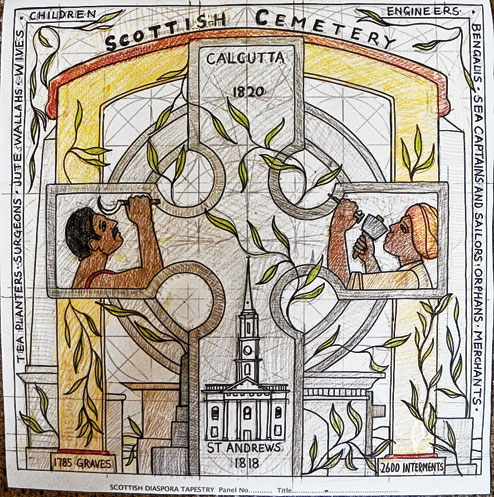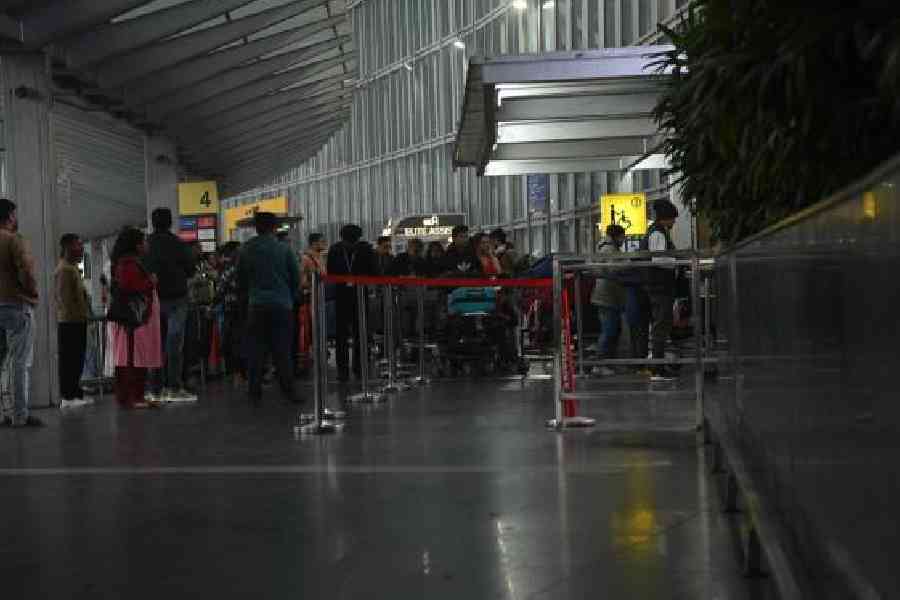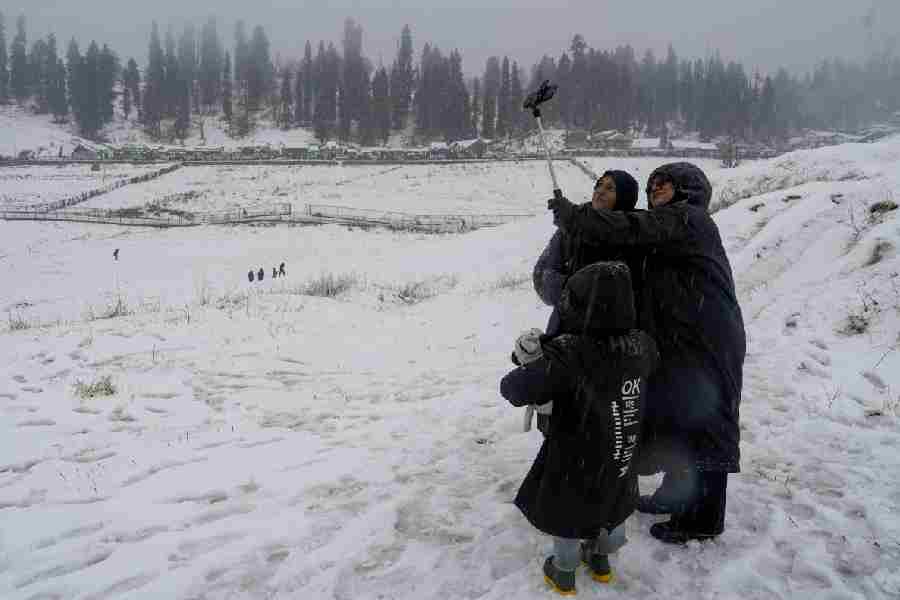| A tale of neglect and restoration | |
 | |
| The tapestry on the restoration of Calcutta’s Scottish cemetery that will tour Scotland | |
 | |
| A broken tombstone on the grave of Rev John C Scrimgeour | |
 | |
| A cluster of broken gravestones bears testimony to decades of neglect | |
 | |
| The entrance to the Scottish cemetery on Karaya Street being restored | |
 |  |
| Restoration work in progress at the Scottish cemetery | |
A tapestry on Calcutta’s Scottish cemetery will be among the 150 panels narrating the history of Scottish emigration that will tour Scotland on the occasion of the Glasgow Commonwealth Games to be held in July and August.
The tapestry — designed, like the other panels, by artist Andrew Crummy and stitched by weavers of the West Bengal Crafts Council — focuses on the restoration of the burial ground under the guidance of the Kolkata Scottish Heritage Trust, set up in 2008.
Premiering on May 31 at the Three Harbours Arts Festival in East Lothian, the tapestries narrating the history of Scottish emigrant communities in China, India, Canada, the US, Sweden, Italy, Poland, the Netherlands and France will tour Stirling, Edinburgh, Paisley, Inverness and Wick till October 25.
The beginning of the Scottish story in India, especially in Calcutta, coincided with the 1707 union between Scotland and England. (A referendum on whether Scotland would break out of the union is scheduled for September 18, 2014.) It was from then that the Scots began working in the East India Company as physicians, skippers and mercenaries. By 1820, they were coming to India in droves as writers (clerks), traders, engineers, missionaries, tea and indigo planters, jute traders and teachers.
The Calcutta panel describes the Scottish diaspora as “tea planters, surgeons, jutewallas, wives, children, engineers, Bengalis, sea captains and sailors, orphans, merchants”.
It portrays the trust’s initiative to rescue the tombs at the Karaya Street address from wild vegetation and efforts to restore it with help from craftsmen from Murshidabad.
Established in 1820, the six-acre cemetery was in use till 1940. It has around 4,300 graves. Apart from Scots, a few Bengalis who were converted to Christianity by Scottish priests were also laid to rest there.
Most of the tombstones at the cemetery lie broken, defaced and forgotten. Weeds have obscured the gorgeous carvings.
“The Scottish cemetery project is advancing on several fronts, though a lack of funds is limiting the activities to some extent,” Lord Charles Bruce, the chairman of the Kolkata Scottish Heritage Trust, told Metro during a recent visit to Calcutta. “The trust raises and spends around 30,000 pounds a year but we wish we had the kind of support the Danish initiative at Serampore has.”
Assisted by a grant from the British Association for Cemeteries in South Asia, the trust has arranged for the copying and rebinding of a dozen handwritten leather-bound burial registers recovered from Calcutta’s St. Andrews Church in advanced stages of decay.
“The registers have around 2,640 names. In 2013, we had launched training courses in Calcutta for students of architecture as part of a conservation programme headed by conservation architect Neeta Das, who has been trained in traditional building technologies in Scotland,” said Lord Charles.
The trust has also joined hands with Presidency University and the University of St. Andrews (Scotland) for a two-year research programme, Narratives of Migration and Exchange. The digital documentation project has identified the Scottish cemetery as a core strand in the narrative of Indian history of the colonial era.
Souvik Mukherjee, an assistant professor at Presidency’s department of English, who is heading the documentation project, has unearthed a lot of information from epitaphs, burial records and gazettes. He seems confident to build a massive database of information that might assist all kinds of research.
Among the interesting characters Mukherjee has documented from the cemetery are James Wheatley (a policeman who was murdered on the beat in 1844), Charles Brown (an indigo planter) and Kaliprasanna Choudhury (a surgeon from Burdwan who converted to Christianity).
Metro recently attended a memorial service in honour of Dr Thomas Nelson Annandale, the founder-director of the Zoological Survey of India, who was buried at the Scottish cemetery. Close to Annandale’s tomb is a half headstone bearing the inscription, “In Memoriam of Rev John C Scrimgeour MA, DD missionary Duff College 1897-1908 and Scottish Churches College 1908-1925”.
An Internet search revealed one Rev. John Cockburn Scrimgeour of Dundee, who was a professor of English literature and moral philosophy and came to Calcutta in 1896. Within a year and a half, he was able to preach in Bengali after topping an honours examination in the language.
He also received an honorary doctorate in divinity from the University of St. Andrews.
According to Lord Charles, many of the stones used at the Scottish cemetery were brought to India as ballast from Scotland — often granite from Aberdeen. The ships returned with jute.
There is a substantial interest in Calcutta among Scots, many of whom have relatives buried here. A former member of British parliament, Tam Dalyell, for instance, has 36 relatives who lived and worked in India for over 200 years.
“There is a huge many-layered narrative in the correspondence between individuals of the two countries. The National Library of Scotland in Edinburgh, for instance, has letters that flew back and forth between Rabindranath Tagore and Patrick Geddes, Rammohun Roy and Alexander Duff. In a way there is a Scottish thread in the intellectual awakening and the growth of Indian nationalism,” said Lord Charles.
He pleaded that Indians and Scots collaborate in the restoration of the cemetery. “The people of Calcutta should realise that the cemetery, like the Roxburgh Building, built for Scottish surgeon and botanist William Roxburgh, the once-magnificent Duff College building, named after Scot missionary and pioneering educationist Alexander Duff, and Scottish Church College, are all part of Indian history. There is a huge demand among international tourists for places with stories to tell and this could be one of them,” said Lord Charles.










